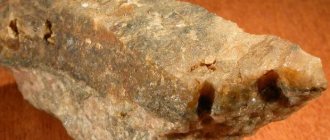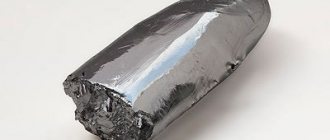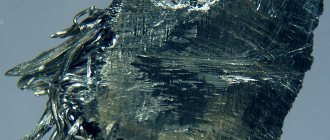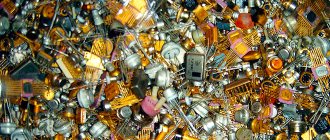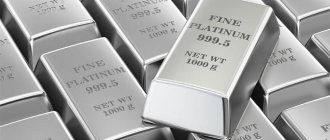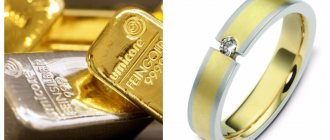How metal was discovered
Ruthenium came into the sphere of interest of scientists in the mid-19th century, when platinum fever began in the Urals.
However, the story turned out to be complicated:
- In 1827, a German chemist and professor at the University of Dorpat, Gottfried Ozanne, completed a series of works on “unpacking” Ural ore. The presence of three metals unknown to science was discovered, which he named polyne, poluran, and ruthenium.
- The achievement did not resonate with colleagues: most considered it a mistake. And the resulting substance is poorly purified platinum iridium.
- Thirteen years later, Karl Klaus, an ethnic German who was born in Russia and became a professor at Kazan University, undertook to repeat Ozanne’s experiments. He was assisted by the Polish scientist Andrzej Sniadecki.
- Four years later (1844) they introduced about 6 grams of ruthenium. Thus, a new element was discovered and Ozanne’s results were confirmed.
- Scientists examined the physical and chemical properties, established the atomic mass, and the amount of ruthenium - 1.1%.
The metal is named after the country where it was first discovered. This is what the discoverer Gottfried Ozanne suggested. Russia took its place in the periodic table.
Ruthenia is a Latinized version of the toponym Russia. This is how the state was called Europe until the 15th century.
According to another version, the same Snyadetsky was the first to study this chemical element back in 1809. He named the new element vestia, after the asteroid Vesta, discovered two years earlier.
The Soviet scientist S.M. Starostin devoted his entire life to the study of metal.
Physico-chemical characteristics
Ruthenium is endowed with characteristics characteristic of other platinoids: increased hardness (6.5 Mohs), resistance to chemical substances, including aggressive ones.
| Properties of the atom | |
| Name, symbol, number | Ruthenium (Ru), 44 |
| Atomic mass (molar mass) | 101.07(2) a. e.m. (g/mol) |
| Electronic configuration | [Kr] 4d7 5s1 |
| Atomic radius | 134 pm |
| Chemical properties | |
| Covalent radius | 125 pm |
| Ion radius | (+4e) 67 pm |
| Electronegativity | 2.2 (Pauling scale) |
| Electrode potential | 0 |
| Oxidation states | +3, +4, +6, +8, 0 |
| Ionization energy (first electron) | 710.3 (7.36) kJ/mol (eV) |
| Thermodynamic properties of a simple substance | |
| Density (at normal conditions) | 12.41 g/cm³ |
| Melting temperature | 2334 °C (2607 K, 4233 °F) |
| Boiling temperature | 4077 °C (4350 K, 7371 °F) |
| Ud. heat of fusion | (25.5) kJ/mol |
| Molar heat capacity | 24.0 J/(K mol) |
| Molar volume | 8.3 cm³/mol |
| Crystal lattice of a simple substance | |
| Lattice structure | hexagonal |
| Lattice parameters | a=2.706 c=4.282 Å |
| c/a ratio | 1,582 |
| Debye temperature | 600 K |
| Other characteristics | |
| Thermal conductivity | (300 K) 117.0 W/(m K) |
| CAS number | 7440-18-8 |
There are distinctive features:
- Effective hydrogen sorbent: a ruthenium cube with an edge of 1 cm is capable of absorbing 1500 cm3 of hydrogen. This is almost twice as much as palladium (940 cm3), recognized as the standard for this characteristic.
- The properties of tetravalent ruthenium oxide are interesting. Externally, these are yellow needles with a golden tint. Even at room temperature (25°C) they melt to liquid, emitting the smell of ozone. Without this component, it is impossible to separate ruthenium from other metals and achieve maximum purification.
The metal is fragile and easily abraded to powder.
Metal in nature
In terms of prevalence, ruthenium is perhaps the rarest of the noble metals: its share in the earth’s crust is 1x2-6%. Meteorites contain 200 times more substance.
The total mass of explored reserves of ruthenium is estimated at 5 thousand tons.
The mineral is found using the following markers:
- Bedrock deposits or placers of platinum-bearing rocks.
- Deposits of copper-nickel ores.
- Deposits of laurite and ruthenarsenide.
Laurite and ruthenarsenide are ruthenium's own minerals. The first is dark, dense, rich in ruthenium. Both are extremely rare.
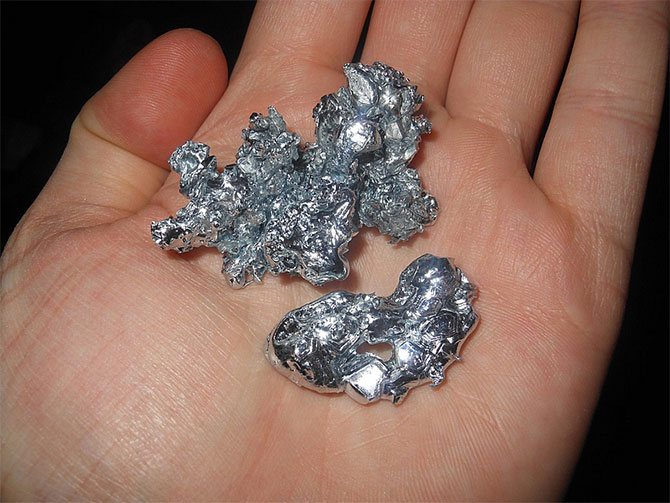
Where is it mined?
Ruthenium is mined in the same place as platinum or platinoids:
- SOUTH AFRICA;
- Zimbabwe;
- Russia;
- China;
- USA.
The main supplier of raw materials is the Republic of South Africa.
The annual global ruthenium production rate is 17-21 tons.
Receiving technologies
- Ruthenium is extracted from platinum or nickel-copper ore. Moreover, they do this when the raw materials are “purified” of other valuable elements. That is, the main source of the metal is the waste remaining as a result of the purification of platinum or metals of its group. The full cycle (including ore enrichment and thermochemical treatment) takes one and a half months.
- The second source is the contents of spent fuel rods, nuclear waste. The materials are uranium, thorium, and plutonium. A ton of radioactive decay product contains up to 250 grams of ruthenium.
- The third is a technetium isotope irradiated by a neutron flux.
Ruthenium incident in the Urals
One of the reasons for the increased public interest in the effects of ruthenium-106 on humans was the incident involving this isotope in the Urals . Conflicting information received about the radiation dose and where it came from caused panic and confusion among the local population. According to statements by researchers from Germany, a cloud of ruthenium-106 spread throughout Europe, and the concentration was extremely high. Russian media refute this claim, claiming that radiation levels remained within established safety standards.
The first signs of a leak were discovered in late September - early October 2021. Some claim it came from the production of nuclear weapons components, but its management denies this, arguing that the elements that lead to the release of ruthenium-106 are not used in production. Roshydromet initially confirmed the fears of German experts, but then almost immediately retracted its statement.
Studies requested and conducted by various organizations have also shown conflicting results. According to some of them, the level of ruthenium-106 in the study area exceeded the usual value hundreds of times - more precisely, 986 and 440 times in the villages of Argayash and Nagorny Chelyabinsk. However, other media noted that such an increase could have resulted from the complete absence of ruthenium in the study areas in past months. Thus, the appearance of a small amount of this element within the normal range has already become a “hundred-fold increase.”
The truth about whether the area was irradiated with ruthenium-106 remains unclear, as does its origin. Radioactive waves are invisible, silent, odorless, and symptoms of their effects can appear months or years after exposure - this is one of the main dangers of such disasters. Contaminated air, water, food and household items can accumulate and transmit radiation months after its source has disappeared, so extreme caution should be exercised if there is a risk of contact with them.
Where is it used?
Noble metal is in demand as a self-sufficient element and component of alloys.

Industry
The main consumer of metal.
The following industries take it:
- Electronics production.
- Electrochemistry.
- Chemical production.
These areas use 90% of raw materials.
Chemists value the metal for its inertness and catalyst properties:
- It is endowed with the unique property of selectivity in reactions. For this it is in demand in the synthesis of organic and inorganic substances.
- When paired with it, the catalytic activity of platinum increases.
- Ruthenium compounds are used as superoxidants, pigments in glass and enamels.
Advanced industries cannot do without ruthenium as an alloy element:
- They are used to make components and contacts of high-precision devices for the needs of radio, electrical, aerospace technology, and the defense complex. For this, 1.1-4.9% ruthenium in the alloy is sufficient.
- 0.1% ruthenium added to titanium multiplies the anti-corrosion properties of the latter.
- Ruthenium-platinum symbiosis is a material for the manufacture of fuel systems and water purification systems on spacecraft.
- Refractory metal is added to alloys in the manufacture of instruments that measure ultra-high temperatures.
Pure ruthenium is used to coat particularly important parts to make them more mechanically and chemically stable.
Jewelry
In jewelry, the use of metal is twofold: as a reinforcing component of the alloy and as a durable coating .
Products made from alloys with ruthenium alloy are reliable and durable, which is important for jewelry that experiences increased loads (rings, rings, bracelets).
Ruthenium coating creates a film on the surface of the product in a range of shades from graphite to black.
Together with rhodium they create elite black gold.
Impact protection
The answers to questions about why ruthenium-106 is dangerous and what protection exists against it are the same as for any other radioactive isotope. When it breaks down, it releases beta particles and gamma rays, which negatively affect the human body. The best way to avoid them is to stay out of their range during this process.
If interaction with the substance has already occurred, you must immediately leave the contaminated area. Radiation tends to accumulate, and the longer this happens, the stronger the negative effect on the body, which is why long-term exposure is especially dangerous. After leaving the infected area, you need to get rid of clothes and thoroughly wash your entire body with a mild soap solution several times.
Surrounding objects can also provide protection from radiation. To stop a beta particle, a thin sheet of aluminum will be enough, but to stop a gamma wave, a thick brick wall will be needed.
Workers who are constantly in areas with increased pollution are protected from harmful effects by special suits with parts made of lead, tungsten, tantalum and other metals with similar properties. They come complete with gas masks and special masks with goggles. There are also special means and preparations that are introduced into the body before interacting with radiation and neutralize its harmful effects.
The level of infection can be determined using special devices called dosimeters. Its maximum permissible level in places of production is 4.4·10² Bq·m³/year, and in ordinary populated areas - 4.4 Bq·m³/year. The background radiation activity that a person receives every day from the environment (and even from elements in his own body) is practically harmless and cannot be protected from it.
What is interesting for scientists
Ruthenium has cast a spell on many generations of scientists. It turned out that some of its characteristics almost copy the platinoids rhodium and osmium, others - iron.
But almost two hundred years after the discovery of the element, questions remain:
- The main obstacle is created by valence. Ruthenium has eight types. This is not the worst thing. During experiments, valence spontaneously and unexpectedly changes.
- Non-standard catalytic capabilities. It is difficult to vouch for the outcome of the process: the metal itself “decides” which element to help accelerate and which not.
Therefore, it has not yet been possible to obtain stable pure metal.
These circumstances only provoke scientists, especially young people. They intend to tame the wayward metal. Particularly attractive areas are the complete and economically optimal extraction of the element from minerals, sludge, and nuclear waste.
Biological effects
Like platinum, nanodoses of ruthenium are present in the tissues of biological organisms (in humans, these are muscles).
The metal and its compounds are biologically active. This property is used by dermatologists, oncologists, and phthisiatricians.
Of particular note is the inorganic dye known as “ruthenium red.” It contrasts tissue and other biological substances examined under a microscope.
However, there are compounds that are dangerous to humans:
- Dioxide Very poisonous, causes vomiting and suffocation. Provokes allergies, ulcers on the mucous membranes.
- Quadrivalent oxide . Exposure to organics (for example, alcohol) or heating above 100°C is enough to cause an explosion.
This should be taken into account if there are fans of home chemical experiments in the family. Such substances are stored in special containers.
Effect on the human body
The consequences of exposure to ruthenium are serious and long-lasting. It affects not only the current health of the population, flora and fauna in the area of infection, but also the genetic material transmitted to subsequent generations. Compared to cesium-137 and some other isotopes, the half-life of Ruthenium-106 is not so long, but this time is still enough to cause enormous damage to the entire spray area.
Symptoms of poisoning appear gradually and with a delay, so the effect of ruthenium-106 on the human body is not immediately noticeable. Its description corresponds to the general list of signs of irradiation with beta and gamma particles.
Immediately after contact with the element, the following symptoms may occur:
- elevated body temperature - from 37-38 °C and above;
- low blood pressure;
- diarrhea and lack of appetite;
- the appearance of redness, rashes, small wounds and other signs of skin irritation.
The further development of the disease depends on the nature of the radiation. Very high one-time doses of ruthenium-106 can kill within 2-4 days or even hours, but most often a person dies within a few months due to the destruction of cells in the bone marrow, intestines, stomach, blood vessels and other oralcons, leading to their dysfunction, etc. complicate in the form of sepsis, blood cancer and the development of malignant tumors. All disturbances in this process appear with a delay; the situation may appear as if the person is getting better (the so-called walking corpse syndrome), even if he received a dose considered absolutely fatal.
With prolonged exposure to lower, but still dangerous doses, ruthenium-106 and its decay products gradually accumulate in the body and manifest themselves with a long delay (sometimes up to six months or more) in the form of various diseases. They could be:
- disturbances in the functioning of the gallbladder, liver and biliary system;
- problems with potency in men, irregular and painful menstrual cycle in women;
- stomatitis;
- fatigue, drowsiness, sleep disturbances;
- confusion, sudden mood swings, emotional breakdowns and neuroses;
- hair and teeth loss, brittle nails;
- changes in blood composition: anemia, leukemia, agranulocytosis, coagulation disorders, leading to bleeding from the nose and gums in mild cases and multiple hemorrhages in severe cases;
- cardiovascular diseases of various types, developing against the background of tachycardia and persistently low blood pressure;
- damage to bone marrow tissue;
- development of various oncological diseases;
- in the case of a severe progressive course of the disease - multiple necrosis, infections, sepsis and general intoxication of the body, ultimately leading to death.
The breadth of exposure and gradual onset of symptoms make diagnosis very difficult. In the absence of proper intervention from specialists, radiation slowly destroys the body at all levels.
